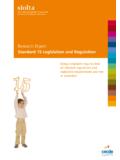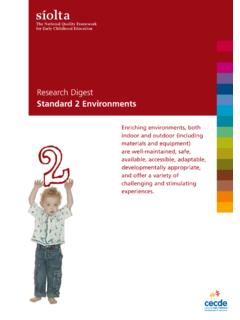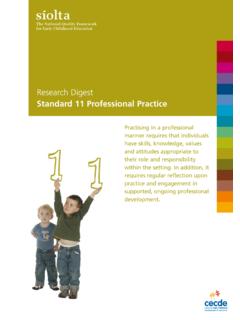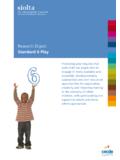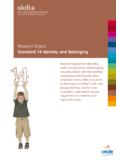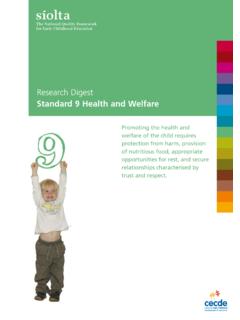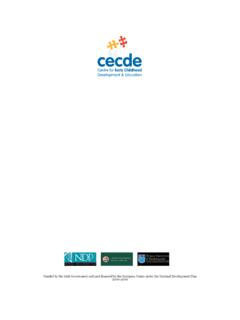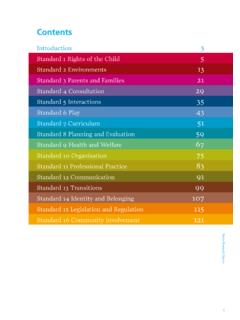Transcription of Research Digest - siolta.ie
1 The National Quality Framework for Early Childhood Educations oltaResearch Digest Standard 8 Planning and EvaluationEnriching and informing all aspects of practice within the setting requires cycles of observation, planning, action and evaluation, undertaken on a regular basis. Research Digest s olta Planning and Evaluation IntroductionPlanning and evaluation are essential building blocks in the process of aiming for best practice, as they are integral to the realisation of achieving quality in early childhood care and education (ECCE). Both activities inform practice, determine review structures and facilitate change. By engaging in regular cycles of observation, planning, action and evaluation, the setting: Is provided with a clear sense of purpose Has named goals (which should be time-related and achievable) Has clearly identified roles, rights and responsibilities Should benefit from a high level of organisationS olta is a strategic tool for planning and evaluation in early years practice.
2 In addition to being a support for individual and/or team professional practice and development, it is also a tool for management, strategic planning and policy development. Its sixteen Standards provide a benchmark against which all aspects of practice can be observed, planned and evaluated on a regular basis. Research Digest s olta Planning and Evaluation Recent ResearchReview processesThe purpose of undertaking regular review of practice is to make informed judgements about the quality and effectiveness of the whole service, with a view to enhancing the care and education of the children within the setting (French, 00 ). Practitioners, therefore, need to know how to ensure that the sixteen Standards of S olta are supported and sustained. Processes of review require embracing a reflective approach to practice (individually and in teams) within a culture which values pedagogical thinking.
3 The benefits are thoughtful practice which is critically analysed and informed by theory, Research and experiences (Adams, 005). According to Te Whariki (Ministry of Education, 1996), planning and reviewing should be a continuous process, involving careful observation, identification of needs and capabilities, provision of resources, assessment and evaluation. Planning and reflection can be ongoing, on a daily, weekly, term or annual basis. Guidelines for effective planning include establishing current conditions, being goal oriented by setting out objectives and associated goals logically, and adapting service plans to meet these goals. Furthermore, sequencing events is important, by outlining the steps required to meet the goal and the appropriate order in which those steps take place (Kelly, 000). Finally, having devised a plan, it is essential that the plan be adhered to.
4 Fig demonstrates the process of review adapted from the writings of Pascal and Bertram (1994). Documented review structures The key to achieving successful monitoring and review is to develop a consistent routine which allows for self-reflection, team reflection and evaluation and, where resources allow, external evaluation (French, 005). Staff teams need time to reflect individually with children and together on the progress of activities and learning opportunities. This can act as a basis for record keeping; for the management of the curriculum; for the general operation of the service and the work with children and families (Hutchin, 1999). To facilitate good communication Research Digest s olta Planning and Evaluation4 Research Digest s olta Planning and EvaluationReflection Review on evaluation and planning process What is the impact of the Action plan?
5 Evaluation Documentary analysis Observation Interviews What works well? What to modify? Implementation Commitment Communication Monitoring Specific feedback Evidence Humour + Energy Action Planning Priorities - What? Resources - How? Expertise - Who? Time - When?Fig. : The Quality Enhancement Review ProcessQuality Enhancement Review ProcessAuthentic, Collaborative Team Approach 5between staff, time should be allocated to regularly review practice daily, weekly, and once per term. This facilitates: Short term planning focused on individual children s needs informed by observation and assessment Medium term planning to support general interests and needs across the group Longer term planning to enhance the learning intentions and possibilities over a year (Hutchin, 1999)The outcomes of all meetings should be recorded.
6 A commitment to quality and professional development of staff necessitates the operation of appraisal (at the beginning of an employee s contract and then annually) and supervision systems. Staff are provided with a non-threatening, routine occasion to individually evaluate their performance at work and establish setting, professional and personal needs. It is recommended that annual open evaluation of the service by management, staff, children and parents, where objectives for the forthcoming year are set, is undertaken. Broad aims and the specifics of how they are to be achieved are outlined. Every aspect of the service is evaluated. This evaluation should be written out, publicised and made available to all concerned with the service (French, 00 ). Implementation Rodd ( 006) observes that where regular review of practice and policy takes place, change is an ongoing, inevitable and necessary process.
7 The process of implementation involves change in organisational policies and procedures as well as individual attitudes and skills. Consensual and joint decision-making styles in cooperation with management make resistance to change less likely to occur. Rodd ( 006) advocates communication and education, participation and involvement, facilitation and support, negotiation and agreement and preparing for change. Effective implementation involves change being understood by leaders as a people-oriented process, through maintaining Research Digest s olta Planning and EvaluationReflection Review on evaluation and planning process What is the impact of the Action plan?Evaluation Documentary analysis Observation Interviews What works well? What to modify? Implementation Commitment Communication Monitoring Specific feedback Evidence Humour + Energy Action Planning Priorities - What?
8 Resources - How? Expertise - Who? Time - When?Fig. : The Quality Enhancement Review ProcessQuality Enhancement Review ProcessAuthentic, Collaborative Team Approach staff self-esteem, providing positive feedback on staff s implementation, and continual review to evaluate the effects of the change in order to make adjustments. Although the responsibility for monitoring rests with the management, it is up to all adults to ensure that the service continues to meet the needs of the children (Rodd, 006). Recording and storing Methods of record-keeping, reporting and assessment will vary from setting to setting. A framework for recording may include observations of each child as part of regular and ongoing assessment, observations to check safety, records of parent meetings and their concerns, comments or requests (Bruce and Meggitt, 00 ). In addition to the records required by the Child Care (Pre-school Services) Regulations 2006 (Department of Health and Children, 006), records of supervision, appraisal and staff meetings should be maintained.
9 Whatever records are kept in the service, it is essential that a reliable system for their storage and retrieval is devised. A simple filing system with names and numbers that will enable location of information quickly should be devised, and kept regularly weeded of out-of-date information. Five years is the recommended length of time to retain records. All information pertaining to the children, either handwritten, typed or videotaped, is confidential and should be kept in a locked drawer or filing cabinet and shared only as appropriate (French, 00 ). ( Research Digests/Standards 10:Organisation and 1 :Communication). Research Digest s olta Planning and Evaluation6 Research Digest s olta Planning and EvaluationImplementing the StandardIn order to achieve the goal of enriching and informing all aspects of practice within the setting, each area of practice should be reviewed regularly through appropriate and tailored processes of observation, planning, action and evaluation.
10 When considering what type(s) of review processes are appropriate to each of S olta s sixteen Standards, the following could be considered: Person-centred review Structural review Resource review Evidence and documentation Change management review External review processManagers and practitioners, mindful of the needs particular to their own setting, should also recognise that certain aspects of the Standards require more frequent review than others. Mechanisms to ensure that review processes lead to changes in practice need to be clearly identified. When change is deemed necessary by such a review process, the relevant person/people to implement and oversee those changes need to be the outcomes of review structures and processes determine the level of improvement and enrichment within a setting, it is essential that they are recorded, stored and, where appropriate, shared.
